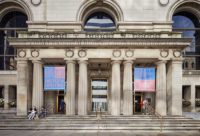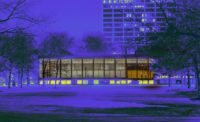Chicago Architecture Biennial Announces Inaugural Lineup

Allzone
Open Air Market

Andrés Jaque, Escaravox

Aranda\Lasch
Palais des Arts

Atelier Bow-Wow
BMW Guggenheim Lab

Bureau Spectacular, Township of Domestic Parts

Frida Escobedo
La Tallera

Giancarlo Mazzanti
Forest of Hope

Johnston Marklee
Vault House

Kéré Architecture
Primary School

Minsuk Cho
Osulloc Tea Stone

MOS Architects
School No. 1

NLE
Makoko Floating School

OH
Double Helix House

OPEN Architecture
Youth and Cultural Center

Pedro & Juana
Hotel Palenque

RAAAF
Venice Architecture Biennale 2010

SelgasCano
Merida Factory Youth Movement

Sou Fujimoto Architects
Serpentine Pavilion

Tatiana Bilbao
Pilgrim's Route

Vo Trong Nghia
Farming Kindergarten




















Bureau Spectacular, Township of Domestic Parts
The Chicago Architecture Biennial, to take place October 3 through January 1, today unveiled the programming for its inaugural edition, to be the first of its kind in North America. The survey, themed “The State of the Art of Architecture,” will include both new and commissioned works from 63 participating firms—including Bjarke Ingels Group, Sou Fujimoto, Studio Gang, 2015 Venice Golden Lion winner Mass Studies—from a total of 30 different countries based in cities as far flung as Bangkok to Rio de Janeiro.
The list of participating firms will continue to grow in the coming months to include approximately 100 firms, according to co-artistic director Joseph Grima, a Genoa-based architect, curator, and editor.
“We’re looking to the younger generation,” he says. “Our ambition is to reaffirm the role of architecture as a form of cultural production. The way we practice today is based on mobility and shared ideas, as opposed to the proprietorship of the heroic architecture of the 20th-century.”
Architects will present projects in the Chicago Cultural Center, an 1897 Landmark Beaux-Arts building that serves as the main exhibition site, as well as in Millennium Park, the historic Water Tower, the Lake Michigan shoreline, and the 72 E. Randolph building. Seeking not only industry discourse but public engagement and visibility, the programming is scheduled to feature an opening summit, weekly Wednesday architectural film screenings and architectural tours, as well as educational programming for Chicago Public School students and their families. Each Friday, the Chicago Cultural Center will host late-night talks and performances. Admission to these events will be free.
“We are creating a program that is equally for the field of architecture and the general public,” said co-artistic director Sarah Herda, who is also the director of the Graham Foundation. “One of the most unique aspects about the biennial will be how public it will be. We think of the city as the site.”
Chicago itself will be an ideal host for the first North American architecture biennial, not only for its architectural legacy, but also for some of its challenges. The biennial’s content extends beyond the strict definitions of architecture to address the racial tensions and socioeconomic disparities tied to Chicago’s urban fabric, issues faced by cities around the world. Artist Theaster Gates, a Chicago native who has transformed derelict buildings on Chicago’s South Side into cultural institutions, will also be a major collaborator. His Stony Island Arts Bank, a decrepit space he transformed into a cultural center, will also host Biennial events. Additionally, photographer Iwan Baan has been commissioned to capture the residential, vernacular buildings that are overshadowed by the city’s more famous architecture.
“The exhibition is rooted in Chicago, but it speaks to a broader condition,” says Grima. “The participants understand architecture as an expression of who we are and not simply as an answer to our needs for shelter. Born in the 21st century, the Biennial’s whole attitude reflects who we are today, not who we were 100 years ago.”
Public Opening Weekend takes place October 3-4. The list of participants is below.
• Al Borde (Quito, Ecuador);
• all(zone) / Rachaporn Choochuey (Bangkok, Thailand)
• Andreas Angelidakis (Athens, Greece)
• Andrés Jaque Architects (Madrid, Spain and New York, NY)
• Assemble (London, United Kingdom)
• Atelier Bow Wow (Tokyo, Japan)
• Iwan Baan (Amsterdam, The Netherlands)
• Erin Besler (Chicago, IL)
• Tatiana Bilbao (Mexico City, Mexico)
• Bjarke Ingels Group / BIG (Copenhagen, Denmark)
• Santiago Borja (Mexico City, Mexico)
• Carlos Bunga (Barcelona, Spain)
• Bureau Spectacular / Jimenez Lai (Chicago, IL and Los Angeles, CA)
• Cusutoras & Liando (Jakarta, Indonesia)
• Design with Company (Chicago, IL);
• El Equipo de Mazzanti / Giancarlo Mazzanti (Bogota, Colombia)
• Frida Escobedo (Mexico City, Mexico)
• Didier Faustino (Paris, France)
• Sou Fujimoto (Tokyo, Japan)
• Indie Architecture & Paul Preissner Architects (Denver, CO)
• John Ronan Architects (Chicago, IL)
• Johnston Marklee (Los Angeles, CA)
• Kéré Architecture / Francis Kéré (Gando, Burkina Faso and Berlin, Germany)
• Kuehn Malvezzi (Berlin, Germany)
• Aranda Lasch (Tucson, AZ and New York, NY)
• Yasmeen, Lari (Pakistan)
• LIST: Ido Avissar (Paris, France)
• MAIO / Ana Puigjaner, Maria Charneco, Alfredo Lérida & Guillermo Lopez (Barcelona, Spain)
• Marshall Brown Projects (Chicago, IL)
• Mass Studies / Minsuk Cho (Seoul, Korea)
• Moon Hoon (Seoul, Korea)
• MOS / Michael Meredith and Hilary Sample
• New-Territories / Roche, Francois (New York, NY)
• NLÉ / Kunlé Adeyemi (Lagos, Nigeria and Rotterdam, Netherlands)
• Norman Kelly (Chicago, IL)
• OFFICE (Antwerp, Belgium)
• Onishimaki + Hyakuda (Tokyo, Japan)
• OPEN / Li Hu & Huan Wenjing (Beijing, China)
• othersothers / David Neustein & Grace Mortlock (Sydney, Australia)
• Pedro&Juana (Mexico City, Mexico)
• Pezo von Ellrichaussen (Concepcion, Chile)
• Plan:b Arquitectos / Felipe Mesa & Federica Mesa (Medellin, Colombia)
• Port Urbanism: Andrew Moddrell (Chicago, IL)
• Productora (Mexico City, Mexico)
• RAAAF / Ronald Rietveld, Erik Rietveld & Arna Mackic (Amsterdam, Netherlands)
• Bryony Roberts (Los Angeles, CA and Oslo, Norway)
• RUA Arquitetos: Pedro Evora & Pedro Rivera (Rio di Janeiro, Brazil)
• Rural Urban Framework: John Lin & Joshua Bolchover (Hong Kong)
• SO-IL / Jing Liu, Florian Idenburg & Ilias Papageorgiou (New York, NY)
• Studio Albori (Milan, Italy)
• Studio D-Tale (Harare, Zimbabwe; Capetown, South Africa; and London, UK)
• Studio Gang / Jeanne Gang (Chicago, IL)
• TOMA (Santiago, Chile)
• UrbanLab (Chicago, LA);
• VTN (Ho Chi Minh City, Vietnam)
• WAI Architecture Think Tank (Beijing, China)
• Weathers: Sean Lally (Chicago, IL)
• Amanda Williams (Chicago, IL)
• WorkAC / Amale Andraos & Dan Wood + Ant Farm (New York, NY)




